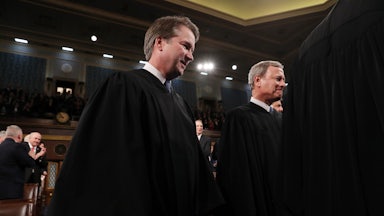The Supreme Court announced on Wednesday that it would take up its first abortion-related case since overturning Roe v. Wade last year. Abortion rights groups could not have asked for a better start to it.
In its latest batch of orders, the court said it would take up FDA v. Alliance for Hippocratic Medicine and Danco Laboratories v. Alliance for Hippocratic Medicine. The consolidated appeals, which all stem from the same original lawsuit, seek to overturn a federal court’s ruling in Texas that, if allowed to take effect, would overturn recent Food and Drug Administration rule changes that made the most widely used abortion pill easier to prescribe and obtain.
But the justices declined to take up a third appeal, Alliance for Hippocratic Medicine v. FDA, that could have allowed them to overturn the FDA’s original approval of mifepristone, the drug in question. By refusing to consider that aspect of the case, the court effectively guaranteed that mifepristone will be available in some form—albeit a potentially more limited one than at present—no matter how it rules on the rest of the matter later this term.
That is a defeat of sorts for the anti-abortion movement, which manufactured these cases out of thin air in an attempt to effectively ban one of the most widely used abortion-inducing drugs. It is also a quiet rebuke to Judge Matthew Kacsmaryk for accepting the plaintiff’s arguments in the first place. Whether it means the court will ultimately preserve the status quo on abortion is unclear. I say “thin air” because there is no actual substance to the lawsuits in question, and therefore they should be fairly easy for the court to resolve—at least in theory.
There are rules that govern when and how you can file a lawsuit in American courts. Perhaps the most important one is standing. Alliance for Hippocratic Medicine, the original plaintiff in the case, is a group that represents anti-abortion doctors. It sued the FDA in a federal district court in Texas to challenge the agency’s original approval of mifepristone in 2002, as well as subsequent changes to how the drug can be prescribed in 2016 and 2021 that made it easier to obtain. The group argued that the FDA’s approval and amendments were legally flawed and should be overturned.
Legal standing requires plaintiffs to have some skin in the game, so to speak. There must be an injury suffered by the plaintiffs that the court can actually remedy. Otherwise, such a lawsuit doesn’t count as one of the “cases and controversies” that the Constitution allows courts to hear. How standing actually works can be more complicated than this, but the basic principle is fairly self-explanatory.
AHM’s theory of standing is as follows: Mifepristone, like any drug, has a small likelihood of complications. Those complications would be treated by AHM’s members, who may have to complete an abortion to provide the necessary medical care to their patients against their own conscience and who may have to divert resources from other patients. And those complications, the organization claims, are directly tied to the FDA’s approval of mifepristone in the first place.
This is not really how standing is supposed to work. As the federal government noted in its own briefs, courts are not supposed to allow plaintiffs to bring cases based on a probabilistic claim of future injury. This does not mean that courts can’t consider hypothetical injuries, but they must be more imminent than mere speculation. And AHM’s theory is essentially speculation piled upon speculation; a reasonable observer could wonder if it’s merely a pretext for seeking a policy-driven outcome.
If policy-driven outcomes were what it sought, AHM couldn’t have found a friendlier group of judges to hear its case in the lower courts. It filed its initial lawsuit in the Amarillo division of the U.S. district court for the Northern District of Texas. That ensured it would be heard by Judge Matthew Kacsmaryk, who worked for conservative Christian legal groups before his appointment to the bench by Donald Trump in 2019. True to form, Kacsmaryk delivered a highly favorable ruling to AHM where the group prevailed on nearly every point it made.
After Kacsmaryk ruled in AHM’s favor, the appeal was then heard by the Fifth Circuit Court of Appeals, which is by far the most conservative federal appeals court in the country. A three-judge panel sided with the FDA on the 2002 approval but struck down the 2016 and 2021 amendments. The net effect of the ruling would be to significantly limit abortion access nationwide, especially in states where other methods of abortion are currently illegal.
The Fifth Circuit panel concluded that the FDA and its scientific experts hadn’t properly considered the evidence before making the amendments in question. “It failed to consider the cumulative effect of removing several important safeguards at the same time,” Judge Jennifer Walker Elrod wrote for the panel. “It failed to consider whether those ‘major’ and ‘interrelated’ changes might alter the risk profile, such that the agency should continue to mandate reporting of non-fatal adverse events. And it failed to gather evidence that affirmatively showed that mifepristone could be used safely without being prescribed and dispensed in person.”
The Justice Department, for its part, rejected AHM’s claims that it had any reasonable grounds for standing in this case. “To describe those theories is to refute them,” the government said in its petition for review, quoting from major Supreme Court precedents on how standing is supposed to work. “This Court has repeatedly rejected theories of standing that rest on a ‘speculative chain of possibilities,’ especially where, as here, those possibilities depend on ‘unfettered choices made by independent actors.’”
But the Supreme Court’s own approach to standing and injury is muddled at best these days. That seems to be especially true when the issue that the court wants to hear is ideologically or politically charged. In West Virginia v. Environmental Protection Agency, the court found substance in a thin-air argument and knee-capped the EPA’s ability to regulate carbon emissions in power plants by ruling against Obama-era regulations that had never gone into effect and thus had injured no one. And in last term’s decision in Missouri v. Biden, the justices embraced a dubious theory of standing offered by a group of Republican-led states to block the Biden administration’s efforts to forgive billions of dollars in student debt relief, which some of the justices seemed to personally oppose as a matter of policy during oral arguments.
Will the court do the same in the abortion context? In its petition for review in the AHM case, the government also told the Supreme Court that the judiciary should not second-guess that decision-making process. It noted that no court had ever countermanded an FDA approval decision for a specific drug, and that welcoming such an attempt could invite chaos into the highly technical regulatory process.
“In taking that step here,” it argued in its petition, “the Fifth Circuit countermanded a scientific judgment FDA has maintained across multiple administrations; imposed unnecessary restrictions on the distribution of a drug that has been safely used by millions of Americans over more than two decades; and upset reliance interests in a healthcare system that depends on the availability of mifepristone as an alternative to surgical abortion for women who choose to lawfully terminate their early pregnancies.”
The court also said in Dobbs that it was returning the abortion issue “to the American people and their elected representatives.” If the Dobbs majority truly believed that, then the outcome of the AHM case should be simple. An anti-abortion group created a phantasmal lawsuit to achieve a policy outcome that it cannot obtain through the democratic process, brought it before a series of highly favorable judges, and then hoped that the Supreme Court would finish the job.
Wednesday’s decision to take up the narrower aspects of the case and leave the original authorization intact showed that the court was not prepared to give anti-abortion groups everything they want. All that’s left is to decide whether it is willing to inject more chaos into the courts and the FDA approval process to reduce the number of abortions in the United States, or whether it truly believes that question is one for the people, not the courts, to decide.










